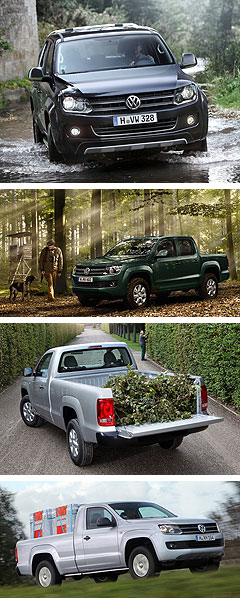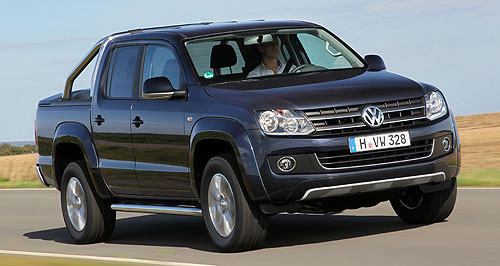Future models - Volkswagen - Amarok - automaticFirst drive: VW Amarok picks up an automaticBeaut utes: Volkswagen has opted to give the Amarok has a class-leading eight-speed ZF automatic option rather than using its dual-clutch DSG technology. Automatic Amarok sets a sky-high benchmark for VW in more ways than one14 Mar 2012 By BYRON MATHIOUDAKIS in SPAIN AN AUTOMATIC transmission will finally finds its way to an expanded Volkswagen Amarok range from July along with more power, lower fuel consumption and greater towing capacity. In Germany the €2500 automatic premium on an Amarok is equivalent to more than $3000, suggesting the auto’s appeal will be limited from the outset - although Australian prices will not be announced until closer to the local launch date. Furthermore, GoAuto understands the automatic will only be optional on the top-of-the-line 4x4 Dual Cab in Highline (currently $52,990 for the six-speed manual) and Ultimate ($56,990 manual) models initially, though according to one Volkswagen spokesman the transmission will spread down the range “in due course”. Brandishing a ZF-supplied eight-speed auto gearbox with Sport and manual modes, the Argentinean-built utility is the first vehicle of its type with such a high number of gear ratios, beating the newer Ford T6 Ranger and Mazda BT-50 twins’ formerly class-leading six-speed alternative. The Amarok auto’s arrival will also coincide with an upgrade of the top-line 2.0-litre four-cylinder bi-turbo diesel engine’s performance, from 120kW to 132kW (still produced at 4000rpm).  While the manual’s torque output of 400Nm from 1500-2000rpm stays the same (meaning the variant remains as TDI400), the automatic version will deliver 420Nm (at 1750rpm), suggesting Volkswagen will call the self-shifting variant the TDI420. While the manual’s torque output of 400Nm from 1500-2000rpm stays the same (meaning the variant remains as TDI400), the automatic version will deliver 420Nm (at 1750rpm), suggesting Volkswagen will call the self-shifting variant the TDI420.It has a braked towing capacity of 3200kg (up from 2800kg in the TDI400 manual), will hit 179km/h in seventh gear and still achieve combined fuel consumption of 7.6 litres per 100 kilometres and CO2 emissions of 199 grams per kilometre – compared with the TDI400 4x4 manual’s 7.9L/100km and 209g/km respectively – in its most frugal state of tune. The improved efficiency is a result of idle-stop technology, included in the Bluemotion Technologies package, which also includes regenerative braking and low rolling-resistance tyres. Also helping economy is the greater spread of transmission ratios between first and top gear – with the latter geared as an overdrive with reduced engine speed for less noise intrusion into the cabin as well as greater efficiency. Conversely, first gear is primarily suitable for off-road or towing work. The entry-level 90kW/340Nm single-turbo diesel (TDI340) version of the 2.0-litre TDI will remain, as will the recently released 2.0-litre four-cylinder turbo-petrol unit delivering 118kW and 300Nm known as the TSI300. As an entry-level variant, the two-seater single cab due to (belatedly) arrive midyear is to be positioned as the no-nonsense workhorse of the Amarok range. At 2205mm, it offers an extra 650mm of cargo tray length on the same wheelbase and vehicle footprint as the dual cab, and cab chassis versions of both body shapes will be available. The Wolfsburg company says the single cab’s interior is slightly larger than that of its direct competitors for improved comfort and storage capability behind the seats. In rear-drive guise, the Amarok single cab manual can manage fuel consumption and CO2 emissions as low as 7.2L/100km and 189g/km. There are also selectable 4x4 and permanent 4x4 options across the range and eventually even these basic Amarok models are expected to adopt the auto as well. According to one Wolfsburg engineer, a conventional torque-converter automatic transmission was chosen over the company’s famous DSG dual-clutch system due to its greater low-speed response and resistance to slip. The latter was also deemed less suitable for off-road applications. On the road, the Amarok TDI420 automatic in up-spec Ultimate Dual Cab guise is nothing short of an eye-opener for this sort of vehicle, offering smooth and intuitive gear changes pretty much across the whole driving spectrum. Driving a pick-up with eight speeds is slightly surreal, considering that only very recently luxury brands like Jaguar switched to this many ratios. Over some of south-eastern Spain’s hillier terrain the new 132kW/420Nm 2.0-litre bi-turbo four-cylinder unit did keep itself busy switching from gear to gear, but the response times certainly made the automatic Amarok more pleasurable to drive than the already civilised manual version. Thoughts like ‘this feels more like a well-sorted SUV than a separate chassis pick-up truck’ sprung to mind when the mountain roads became a bit twistier. Yes, the steering is on the light side, and the feedback from the helm is a tad muted, but we are just being picky because the Volkswagen feels better than any other competitor to drive, including the impressive Ranger. On the warm dry roads leading down to the mountain towards Marbella on the Costa del Sol, this commercial vehicle’s handling, grip and poise are incomparable in this segment. Yet we reckon it is off the beaten track where the Amarok automatic really ups the ante. With the 4Motion drivetrain and ‘off road’ setting at the ready, the tough truck side of this Jekyll and Hyde Volkswagen came to the fore electronics took care of the low-range gears and diff locks at a push of a button, the hill descent control delivered unbelievable braking, and the suspension soaked most of it up. What the Amarok automatic does best, then, is evolve the pick-up truck to new levels of advancement. The interior is VW quality-smart, with a decent pair of bucket seats up front and a Dual Cab rear bench that won’t have its occupants dreaming of an osteo appointment. Noise levels are low, refinement is high, and the ambience is that of tasteful prestige. Only the occasional squeak from the dashboard undermined the civility of it all. We also sampled the new 90kW Amarok Single Cab 4x4 in six-speed manual form over exactly the same Spanish off-road route as the Dual Cab auto, and found it a spacious but appealing mix of go-anywhere capability, comfort and refinement – in fact it was a lot of fun throwing the lighter and more manoeuvrable base pick-up up and down the demanding course. But it did highlight just how effortless and easy the ZF auto makes the 4WD. If the Land Rover Discovery was available as a one-tonne truck then you might imagine the Amarok auto flagship might be a little something like it, going a long way to justify the steep – some might say cynical money-grabbing – top-end pricing that the self-shifter is coming in at. But while greedy pricing might give Volkswagen’s competitors from the HiLux SR5 and Navara ST-X to the Ranger XLT some breathing space, the writing is certainly on the rock wall for them – the Amarok has arrived in force with the auto being the trump card. We look forward to seeing how the fancy automatic Wolfsburg truck fares Down Under.  Read more27th of January 2012  VW Amarok finally gets petrolTurbo petrol power here for Volkswagen Amarok, with auto and single cab in Q318th of November 2011  Volkswagen launches single-cab AmarokTwo-door version of VW Amarok goes on sale in Germany ahead of Oz debut next year15th of September 2011  Frankfurt show: VW Amarok with eight-speed autoEight-speed auto for Australia’s VW Amarok next year – with 132kW ‘TDI420’ engineAll future models Alfa Romeo Alfa Romeo Abarth Abarth Audi Audi Aston Martin Aston Martin BMW BMW Bentley Bentley Chrysler Chrysler Chevrolet Chevrolet Dodge Dodge Citroen Citroen Ferrari Ferrari DS DS Ford Ford Fiat Fiat FPV FPV Foton Foton Haval Haval Great Wall Great Wall Honda Honda Holden Holden Hyundai Hyundai HSV HSV Isuzu Isuzu Infiniti Infiniti Jeep Jeep Jaguar Jaguar Lamborghini Lamborghini Kia Kia Lexus Lexus Land Rover Land Rover Mazda Mazda Maserati Maserati Mercedes-Benz Mercedes-Benz McLaren McLaren Mini Mini Nissan Nissan Mitsubishi Mitsubishi Peugeot Peugeot Opel Opel Proton Proton Porsche Porsche Renault Renault Ram Ram Saab Saab Rolls-Royce Rolls-Royce Smart Smart Skoda Skoda Subaru Subaru SsangYong SsangYong Tesla Tesla Suzuki Suzuki Toyota Toyota Volvo VolvoAmarok pricing
Motor industry news |
Click to shareVolkswagen modelsAll future models Alfa Romeo Alfa Romeo Abarth Abarth Audi Audi Aston Martin Aston Martin BMW BMW Bentley Bentley Chrysler Chrysler Chevrolet Chevrolet Dodge Dodge Citroen Citroen Ferrari Ferrari DS DS Ford Ford Fiat Fiat FPV FPV Foton Foton Haval Haval Great Wall Great Wall Honda Honda Holden Holden Hyundai Hyundai HSV HSV Isuzu Isuzu Infiniti Infiniti Jeep Jeep Jaguar Jaguar Lamborghini Lamborghini Kia Kia Lexus Lexus Land Rover Land Rover Mazda Mazda Maserati Maserati Mercedes-Benz Mercedes-Benz McLaren McLaren Mini Mini Nissan Nissan Mitsubishi Mitsubishi Peugeot Peugeot Opel Opel Proton Proton Porsche Porsche Renault Renault Ram Ram Saab Saab Rolls-Royce Rolls-Royce Smart Smart Skoda Skoda Subaru Subaru SsangYong SsangYong Tesla Tesla Suzuki Suzuki Toyota Toyota Volvo VolvoAmarok pricing
Motor industry news |
















Facebook Twitter Instagram